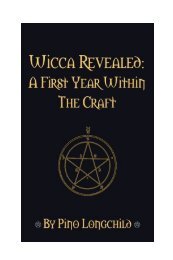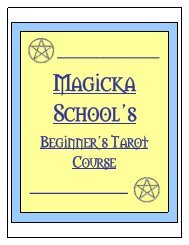A Magickal Herball Compleat.pdf - Magicka School
A Magickal Herball Compleat.pdf - Magicka School
A Magickal Herball Compleat.pdf - Magicka School
Create successful ePaper yourself
Turn your PDF publications into a flip-book with our unique Google optimized e-Paper software.
Sunday, they pick and dig Solsequium, on Monday Lunariam, on Tuesday Verbenam, on<br />
Wednesday Mercurialem, on Thursday Barbam Jovis, on Friday Capillos Veneris. They make<br />
the salve by mixing these with quite a lot of birds’ blood, and also animal lard. I do not write<br />
down details, so as to harm no one. Whenever they want to, they rub it on benches or chairs,<br />
rakes or oven forks and fly away. This is nothing but necromancy, which is strongly forbidden<br />
[18].<br />
Not only was flight supposedly possible, but for a long time in Europe the art of<br />
shape-shifting was attributed to Witches. The earliest surviving account of this is<br />
written of in the second century C.E. work, The Golden Ass by Apuleius:<br />
On a day Fotis came running to me in great fear, and said that her mistress, to work her<br />
sorceries on such as she loved, intended the night following to transform herself into a bird, and to<br />
fly whither she pleased. Wherefore she willed me privily to prepare myself to see the same. And<br />
when midnight came she led me softly into a high chamber, and bid me look through the chink of<br />
a door: where first I saw how she put off all her garments, and took out of a certain coffer sundry<br />
kinds of boxes, of the which she opened one, and tempered the ointment therein with her fingers,<br />
and then rubbed her body therewith from the sole of the foot to the crown of the head, and when<br />
she had spoken privily with her self, having the candle in her hand, she shaked parts of her body,<br />
and behold, I perceived a plume of feathers did burgen out, her nose waxed crooked and hard, her<br />
nails turned into claws, and so she became an owl. Then she cried and screeched like a bird of<br />
that kind, and willing to prove her force, moved her self from the ground by little and little, til at<br />
last she flew quite away [19].<br />
But, apart from a handful of sensationalist works that purport to give true Witch<br />
recipes or more literary musings, there is a lack of first hand accounts from those<br />
who were supposed to have used the ointments. This is the age-old problem of<br />
finding primary evidence for practices associated with Witchcraft and, as usual,<br />
there is a lack of documentation.<br />
However, a great deal of evidence of the use of powerful hallucinogenic plants in<br />
Europe exists, except that they are mentioned without reference to Witches. For<br />
example, henbane had long been used by Germanic peoples to make their ale<br />
more intoxicating [20] until it was eventually banned as an ingredient of beer in<br />
early sixteenth century Bavaria. Deadly nightshade, or belladonna (which means<br />
beautiful woman), was used throughout Renaissance Italy in the form of eye drops<br />
designed to dilate pupils and make women more sexually attractive. And<br />
mandrake (Mandragora officinarum), perhaps the most famous plant associated with<br />
Witches, was frequently used for its medicinal purposes. Because the root could so<br />
often look human in form it was thought to contain a spirit of good fortune and<br />
later, because of the Doctrine of Signatures, was considered to be an especially<br />
potent cure-all.<br />
Not to mention, of course, that all these plants and many of their effects were<br />
widely written of during the Golden Age of Herbals. For example, the Bavarian<br />
Leonhart Fuchs (1501-1566) wrote in De Historia Stirpium Commentarii Insignes<br />
(Notable Commentaries on the History of Plants) [21] that the:<br />
53




